CEFOXITIN AND DEXTROSE- cefoxitin sodium injection, solution
B. Braun Medical Inc.
----------
To reduce the development of drug-resistant bacteria and maintain the effectiveness of Cefoxitin for Injection and Dextrose Injection and other antibacterial drugs, Cefoxitin for Injection and Dextrose Injection should be used only to treat or prevent infections that are proven or strongly suspected to be caused by bacteria.
DESCRIPTION
The drug chamber is filled with cefoxitin sodium USP, a semi-synthetic, broad-spectrum cepha antibiotic sealed under nitrogen for intravenous administration. It is derived from cephamycin C, which is produced by Streptomyces lactamdurans. Its chemical name is sodium (6R,7S)-3-(hydroxymethyl)-7-methoxy-8-oxo-7-[2-(2-thienyl)acetamido]-5-thia-1-azabicyclo[4.2.0]oct-2-ene-2-carboxylate carbamate (ester). The empirical formula is C16H16N3NaO7S2, and the molecular weight is 449.44. The structural formula is:
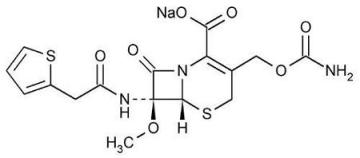
Cefoxitin sodium contains approximately 53.8 mg (2.3 mEq) of sodium per gram of cefoxitin activity.
Cefoxitin for Injection and Dextrose Injection is supplied as a sterile, nonpyrogenic, single use packaged combination of cefoxitin (filled using Cefoxitin Sodium USP) and Dextrose Injection (diluent). After reconstitution, each 50 mL contains cefoxitin sodium equivalent to either 1 gram or 2 grams cefoxitin. The diluent chamber contains Dextrose Injection. The concentration of Dextrose Hydrous USP in Water for Injection USP has been adjusted to render the reconstituted drug product iso-osmotic. Dextrose Hydrous USP has been added to adjust the osmolality to approximately 290 mOsmol/kg (approximately 2 g (4% w/v) and 1.1 g (2.2% w/v) to the 1 g and 2 g doses, respectively). Dextrose Injection is sterile, nonpyrogenic, and contains no bacteriostatic or antimicrobial agents.
Dextrose Hydrous USP has the following structural (molecular) formula:
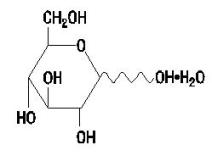
The molecular weight of Dextrose Hydrous USP is 198.17.
After removing the peelable foil strip, activating the seals, and thoroughly mixing, the reconstituted drug product is intended for single intravenous use. When reconstituted according to instructions in the product labeling, the approximate osmolality of the reconstituted solution of Cefoxitin for Injection and Dextrose Injection is approximately 290 mOsmol/kg. After reconstitution, the pH is approximately 6.5. Solutions of Cefoxitin for Injection and Dextrose Injection range from colorless to light amber.
Not made with natural rubber latex, PVC or Di(2-ethylhexyl)phthalate (DEHP).
The DUPLEX® dual chamber container is made from a specially formulated material. The product (diluent and drug) contact layer is a mixture of thermoplastic rubber and a polypropylene ethylene copolymer that contains no plasticizers. The safety of the container system is supported by USP biological evaluation procedures.
CLINICAL PHARMACOLOGY
Clinical Pharmacology
Following an intravenous dose of 1 gram, serum concentrations were 110 mcg/mL at 5 minutes, declining to less than 1 mcg/mL at 4 hours. The half-life after an intravenous dose is 41 to 59 minutes. Approximately 85 percent of cefoxitin is excreted unchanged by the kidneys over a 6-hour period, resulting in high urinary concentrations. Probenecid slows tubular excretion and produces higher serum levels and increases the duration of measurable serum concentrations.
Cefoxitin passes into pleural and joint fluids and is detectable in antibacterial concentrations in bile.
In a pubished study of geriatric patients ranging in age from 64 to 88 years with normal renal function for their age (creatinine clearance ranging from 31.5 to 174.0 mL/min), the half-life for cefoxitin ranged from 51 to 90 minutes, resulting in higher plasma concentrations than in younger adults. These changes were attributed to decreased renal function associated with the aging process.
Microbiology
Mechanism of Action
Cefoxitin is a bactericidal agent that acts by inhibition of bacterial cell wall synthesis. Cefoxitin has activity in the presence of some beta-lactamases, both penicillinases and cephalosporinases, of Gram-negative and Gram-positive bacteria.
Mechanism of Resistance
Resistance to Cefoxitin is primarily through hydrolysis by beta-lactamase, alteration of penicillin-binding proteins (PBPs), and decreased permeability.
Cefoxitin has been shown to be active against most isolates of the following bacteria, both in vitro and in clinical infections as described in the INDICATIONS AND USAGE section:
Gram-positive bacteria
Staphylococcus aureus
Staphylococcus epidermidis
Streptococcus agalactiae
Streptococcus pneumoniae
Streptococcus pyogenes
Gram-negative microorganisms
Escherichia coli
Haemophilus influenzae
Klebsiella spp.
Morganella morganii
Neisseria gonorrhoeae
Proteus mirabilis
Proteus vulgaris
Providencia spp.
Anaerobic bacteria
Clostridium spp.
Peptococcus niger
Peptostreptococcus spp.
Bacteroides distasonis
Bacteroides fragilis
Bacteroides ovatus
Bacteroides thetaiotaomicron
Bacteroides spp.
The following in vitro data are available, but their clinical significance is unknown. At least 90 percent of the following microorganisms exhibit an in vitro minimum inhibitory concentration (MIC) less than or equal to the susceptible breakpoint for cefoxitin. However, the efficacy of cefoxitin in treating clinical infections due to these microorganisms has not been established in adequate and well-controlled clinical trials.
Susceptibility Test Methods
When available, the clinical microbiology laboratory should provide the results of in vitro susceptibility test results for antimicrobial drug products used in resident hospitals to the physician as periodic reports that describe the susceptibility profile of nosocomial and community-acquired pathogens. These reports should aid the physician in selecting an antibacterial drug product for treatment.
Dilution techniques
Quantitative methods are used to determine antimicrobial minimum inhibitory concentrations (MICs). These MICs provide estimates of the susceptibility of bacteria to antimicrobial compounds. The MICs should be determined using a standardized test method 1,3. The MIC values should be interpreted according to criteria provided in Table 1.
Diffusion techniques
Quantitative methods that require measurement of zone diameters also provide reproducible estimates of the susceptibility of bacteria to antimicrobial compounds. The zone size provides an estimate of the susceptibility of bacteria to antimicrobial compounds. The zone size should be determined using a standardized test method 2,3. This procedure uses paper disks impregnated with 30 mcg Cefoxitin to test the susceptibility of microorganisms to Cefoxitin. The disk diffusion interpretive criteria are provided in Table 1.
Table 1. Susceptibility Test Interpretive Criteria for Cefoxitin 2,4
| Minimum Inhibitory Concentrations (mcg/mL) | Disk Diffusion Diameters (mm) | |||||
| Pathogen | S | I | R | S | I | R |
| Enterobacteriaceae | < 8 | 16 | > 32 | > 18 | 15 – 17 | < 14 |
| Neisseria gonorrhoeae | < 2 | 4 | > 8 | > 28 | 24 – 27 | < 23 |
| anaerobic bacteria (Agar Method) | < 16 | 32 | > 64 | Not applicable | ||
A report of Susceptible indicates that the antimicrobial is likely to inhibit growth of the pathogen if the antimicrobial compound reaches the concentration at the infection site necessary to inhibit growth of the pathogen. A report of Intermediate indicates that the result should be considered equivocal, and if the microorganism is not fully susceptible to alternative, clinically feasible drugs, the test should be repeated. This category implies possible clinical applicability in body sites where the drug is physiologically concentrated or in situations where a high dosage of drug can be used. This category also provides a buffer zone that prevents small uncontrolled technical factors from causing major discrepancies in interpretation. A report of Resistant indicates that the antimicrobial is not likely to inhibit growth of the pathogen if the antimicrobial compound reaches the concentrations usually achievable at the infection site; other therapy should be selected.
Quality Control
Standardized susceptibility test procedures require the use of laboratory controls to monitor and ensure the accuracy and precision of supplies and reagents used in the assay, and the techniques of the individual performing the test 1,2,3,4. Standard Cefoxitin powder should provide the following range of MIC values noted in Table 2. For the diffusion technique using the 30 mcg disk, the criteria in Table 2 should be achieved.
Table 2. Acceptable Quality Control Ranges for Cefoxitin
| QC Strain | Minimum Inhibitory Concentrations (mcg/mL) | Disk Diffusion Zone diameters (mm) |
| Escherichia coli ATCC® 25922 | 2 - 8 | 23 - 29 |
| Neisseria gonorrhoeae ATCC® 49226 | 0.5 - 2 | 33 - 41 |
| Staphylococcus aureus ATCC® 25923 | ---------- | 23 - 29 |
| Staphylococcus aureus ATCC® 29213 | 1–4 | ---------- |
| Bacteroides fragilis ATCC® 25285 (Agar method) | 4-16 | ---------- |
| Bacteroides fragilis ATCC® 25285 (Broth method) | 2-8 | ---------- |
| Bacteroides thetaiotaomicron ATCC® 29741 (Agar method) | 8-32 | ---------- |
| Bacteroides thetaiotaomicron ATCC® 29741 (Broth method) | 8-64 | ---------- |
| Eubacterium lentum ATCC® 43055 (Agar method) | 4-16 | ---------- |
| Eubacterium lentum ATCC® 43055 (Broth method) | 2-16 | ---------- |
INDICATIONS AND USAGE
To reduce the development of drug-resistant bacteria and maintain the effectiveness of Cefoxitin for Injection and Dextrose Injection and other antibacterial drugs, Cefoxitin for Injection and Dextrose Injection should be used only to treat or prevent infections that are proven or strongly suspected to be caused by susceptible bacteria. When culture and susceptibility information are available, they should be considered in selecting or modifying antibacterial therapy. In the absence of such data, local epidemiology and susceptibility patterns may contribute to the empiric selection of therapy.
Treatment
Cefoxitin for Injection and Dextrose Injection is indicated for the treatment of serious infections caused by susceptible strains of the designated microorganisms in the diseases listed below.
(1) Lower respiratory tract infections, including pneumonia and lung abscess, caused by Streptococcus pneumoniae, other streptococci (excluding enterococci, e.g., Enterococcus faecalis [formerly Streptococcus faecalis]), Staphylococcus aureus (including penicillinase-producing strains), Escherichia coli, Klebsiella species, Haemophilus influenzae, and Bacteroides species.
(2) Urinary tract infections caused by Escherichia coli, Klebsiella species, Proteus mirabilis, Morganella morganii, Proteus vulgaris and Providencia species (including P. rettgeri).
(3) Intra-abdominal infections, including peritonitis and intra-abdominal abscess, caused by Escherichia coli, Klebsiella species, Bacteroides species including Bacteroides fragilis, and Clostridium species.
(4) Gynecological infections, including endometritis, pelvic cellulitis, and pelvic inflammatory disease caused by Escherichia coli, Neisseria gonorrhoeae (including penicillinase-producing strains), Bacteroides species including B. fragilis, Clostridium species, Peptococcus niger, Peptostreptococcus species, and Streptococcus agalactiae. Cefoxitin, like cephalosporins, has no activity against Chlamydia trachomatis. Therefore, when cefoxitin is used in the treatment of patients with pelvic inflammatory disease and C. trachomatis is one of the suspected pathogens, appropriate anti-chlamydial coverage should be added.
(5) Septicemia caused by Streptococcus pneumoniae, Staphylococcus aureus (including penicillinase-producing strains), Escherichia coli, Klebsiella species, and Bacteroides species including B. fragilis.
(6) Bone and joint infections caused by Staphylococcus aureus (including penicillinase-producing strains).
(7) Skin and skin structure infections caused by Staphylococcus aureus (including penicillinase-producing strains), Staphylococcus epidermidis, Streptococcus pyogenes and other streptococci (excluding enterococci, e.g., Enterococcus faecalis [formerly Streptococcus faecalis]), Escherichia coli, Proteus mirabilis, Klebsiella species, Bacteroides species including B. fragilis, Clostridium species, Peptococcus niger, and Peptostreptococcus species.
Appropriate culture and susceptibility studies should be performed to determine the susceptibility of the causative organisms to cefoxitin. Therapy may be started while awaiting the results of these studies.
In randomized comparative studies, cefoxitin and cephalothin were comparably safe and effective in the management of infections caused by Gram-positive cocci and Gram-negative rods susceptible to the cephalosporins. Cefoxitin has a high degree of stability in the presence of bacterial beta-lactamases, both penicillinases and cephalosporinases.
Many infections caused by aerobic and anaerobic Gram-negative bacteria resistant to some cephalosporins respond to cefoxitin. Similarly, many infections caused by aerobic and anaerobic bacteria resistant to some penicillin antibiotics (ampicillin, carbenicillin, penicillin G) respond to treatment with cefoxitin. Many infections caused by mixtures of susceptible aerobic and anaerobic bacteria respond to treatment with cefoxitin.
Prevention
Cefoxitin is indicated for the prophylaxis of infection in patients undergoing uncontaminated gastrointestinal surgery, vaginal hysterectomy, abdominal hysterectomy, or cesarean section.
If there are signs of infection, specimens for culture should be obtained for identification of the causative organism so that appropriate treatment may be instituted.
CONTRAINDICATIONS
Cefoxitin for Injection and Dextrose Injection is contraindicated in patients who have shown hypersensitivity to cefoxitin and the cephalosporin group of antibiotics.
Solutions containing dextrose may be contraindicated in patients with hypersensitivity to corn products.
WARNINGS
BEFORE THERAPY WITH CEFOXITIN FOR INJECTION AND DEXTROSE INJECTION IS INSTITUTED, CAREFUL INQUIRY SHOULD BE MADE TO DETERMINE WHETHER THE PATIENT HAS HAD PREVIOUS HYPERSENSITIVITY REACTIONS TO CEFOXITIN, CEPHALOSPORINS, PENICILLINS, OR OTHER DRUGS. THIS PRODUCT SHOULD BE GIVEN WITH CAUTION TO PENICILLIN-SENSITIVE PATIENTS. ANTIBIOTICS SHOULD BE ADMINISTERED WITH CAUTION TO ANY PATIENT WHO HAS DEMONSTRATED SOME FORM OF ALLERGY, PARTICULARLY TO DRUGS. IF AN ALLERGIC REACTION TO CEFOXITIN FOR INJECTION AND DEXTROSE INJECTION OCCURS, DISCONTINUE THE DRUG. SERIOUS HYPERSENSITIVITY REACTIONS MAY REQUIRE EPINEPHRINE AND OTHER EMERGENCY MEASURES.
Clostridium difficile associated diarrhea (CDAD) has been reported with use of nearly all antibacterial agents, including Cefoxitin for Injection and Dextrose Injection, and may range in severity from mild diarrhea to fatal colitis. Treatment with antibacterial agents alters the normal flora of the colon leading to overgrowth of C. difficile.
C. difficile produces toxins A and B which contribute to the development of CDAD. Hypertoxin producing strains of C. difficile cause increased morbidity and mortality, as these infections can be refractory to antimicrobial therapy and may require colectomy. CDAD must be considered in all patients who present with diarrhea following antibiotic use. Careful medical history is necessary since CDAD has been reported to occur over two months after the administration of antibacterial agents.
If CDAD is suspected or confirmed, ongoing antibiotic use not directed against C. difficile may need to be discontinued. Appropriate fluid and electrolyte management, protein supplementation, antibiotic treatment of C. difficile, and surgical evaluation should be instituted as clinically indicated.
PRECAUTIONS
General
Prescribing Cefoxitin for Injection and Dextrose Injection in the absence of a proven or strongly suspected bacterial infection or a prophylactic indication is unlikely to provide benefit to the patient and increases the risk of the development of drug-resistant bacteria.
The total daily dose should be reduced when Cefoxitin for Injection and Dextrose Injection is administered to patients with transient or persistent reduction of urinary output due to renal insufficiency (see DOSAGE AND ADMINISTRATION), because high and prolonged serum antibiotic concentrations can occur in such individuals from usual doses.
Antibiotics (including cephalosporins) should be prescribed with caution in individuals with a history of gastrointestinal disease, particularly colitis.
As with other antibiotics, prolonged use of cefoxitin may result in overgrowth of nonsusceptible organisms. Repeated evaluation of the patient's condition is essential. If superinfection occurs during therapy, appropriate measures should be taken.
As with other dextrose-containing solutions, Cefoxitin for Injection and Dextrose Injection should be prescribed with caution in patients with overt or known subclinical diabetes mellitus or carbohydrate intolerance for any reason.
If administration is controlled by a pumping device, care must be taken to discontinue pumping action before the container runs dry or air embolism may result.
Use only if solution is clear and container and seals are intact.
Information for Patients
Diarrhea is a common problem caused by antibiotics which usually ends when the antibiotic is discontinued. Sometimes after starting treatment with antibiotics, patients can develop watery and bloody stools (with or without stomach cramps and fever) even as late as two or more months after having taken the last dose of the antibiotic. If this occurs, patients should contact their physician as soon as possible.
Patients should be counseled that antibacterial drugs including Cefoxitin for Injection and Dextrose Injection should only be used to treat bacterial infections. They do not treat viral infections (e.g., the common cold). When Cefoxitin for Injection and Dextrose Injection is prescribed to treat a bacterial infection, patients should be told that although it is common to feel better early in the course of therapy, the medication should be taken exactly as directed. Skipping doses or not completing the full course of therapy may (1) decrease the effectiveness of the immediate treatment and (2) increase the likelihood that bacteria will develop resistance and will not be treatable by Cefoxitin for Injection and Dextrose Injection or other antibacterial drugs in the future.
Laboratory Tests
As with any potent antibacterial agent, periodic assessment of organ system functions, including renal, hepatic, and hematopoietic, is advisable during prolonged therapy.
Drug Interactions
Increased nephrotoxicity has been reported following concomitant administration of cephalosporins and aminoglycoside antibiotics.
Drug/Laboratory Test Interactions
As with cephalothin, high concentrations of cefoxitin (>100 mcg/mL) may interfere with measurement of serum and urine creatinine levels by Jaffé reaction, and produce false increases of modest degree in the levels of creatinine reported. Serum samples from patients treated with cefoxitin should not be analyzed for creatinine if withdrawn within 2 hours of drug administration.
High concentrations of cefoxitin in the urine may interfere with measurement of urinary 17-hydroxy-corticosteroids by the Porter-Silber reaction, and produce false increases of modest degree in the levels reported.
A false-positive reaction for glucose in the urine may occur. This has been observed with CLINITEST® reagent tablets.
Carcinogenesis, Mutagenesis, Impairment of Fertility
Long term studies in animals have not been performed with cefoxitin to evaluate carcinogenic or mutagenic potential. Studies in rats treated intravenously with 400 mg/kg of cefoxitin (approximately three times the maximum recommended human dose) revealed no effects on fertility or mating ability.
Pregnancy
Pregnancy Category B
Reproduction studies performed in rats and mice at parenteral doses of approximately one to seven and one-half times the maximum recommended human dose did not reveal teratogenic or fetal toxic effects, although a slight decrease in fetal weight was observed.
There are, however, no adequate and well-controlled studies in pregnant women. Because animal reproduction studies are not always predictive of human response, this drug should be used during pregnancy only if clearly needed.
In the rabbit, cefoxitin was associated with a high incidence of abortion and maternal death. This was not considered to be a teratogenic effect but an expected consequence of the rabbit's unusual sensitivity to antibiotic-induced changes in the population of the microflora of the intestine.
Nursing Mothers
Cefoxitin is excreted in human milk in low concentrations. Caution should be exercised when cefoxitin is administered to a nursing woman.
Pediatric Use
Safety and efficacy in pediatric patients from birth to three months of age have not yet been established. In pediatric patients three months of age and older, higher doses of cefoxitin have been associated with an increased incidence of eosinophilia and elevated SGOT.
Geriatric Use
Of the 1,775 subjects who received cefoxitin in clinical studies, 424 (24%) were 65 and over, while 124 (7%) were 75 and over. No overall differences in safety or effectiveness were observed between these subjects and younger subjects, and other reported clinical experience has not identified differences in responses between the elderly and younger patients, but greater sensitivity of some older individuals cannot be ruled out (see CLINICAL PHARMACOLOGY).
This drug is known to be substantially excreted by the kidney, and the risk of toxic reactions to this drug may be greater in patients with impaired renal function. Because elderly patients are more likely to have decreased renal function, care should be taken in dose selection, and it may be useful to monitor renal function (see DOSAGE AND ADMINISTRATION and PRECAUTIONS).
ADVERSE REACTIONS
Cefoxitin is generally well tolerated. The most common adverse reactions have been local reactions following intravenous injection. Other adverse reactions have been encountered infrequently.
Local Reactions
Thrombophlebitis has occurred with intravenous administration.
Allergic Reactions
Rash (including exfoliative dermatitis and toxic epidermal necrolysis), urticaria, flushing, pruritus, eosinophilia, fever, dyspnea, and other allergic reactions including anaphylaxis, interstitial nephritis and angioedema have been noted.
Cardiovascular
Hypotension.
Gastrointestinal
Diarrhea, including documented pseudomembranous colitis which can appear during or after antibiotic treatment. Nausea and vomiting have been reported rarely.
Neuromuscular
Possible exacerbation of myasthenia gravis.
Blood
Eosinophilia, leukopenia including granulocytopenia, neutropenia, anemia, including hemolytic anemia, thrombocytopenia, and bone marrow depression. A positive direct Coombs test may develop in some individuals, especially those with azotemia.
Liver Function
Transient elevation in SGOT, SGPT, serum LDH, and serum alkaline phosphatase; and jaundice have been reported.
Renal Function
Elevations in serum creatinine and/or blood urea nitrogen levels have been observed. As with the cephalosporins, acute renal failure has been reported rarely. The role of cefoxitin in changes in renal function tests is difficult to assess, since factors predisposing to prerenal azotemia or to impaired renal function usually have been present.
In addition to the adverse reactions listed above which have been observed in patients treated with cefoxitin, the following adverse reactions and altered laboratory test results have been reported for cephalosporin class antibiotics:
Urticaria, erythema multiforme, Stevens-Johnson syndrome, serum sickness-like reactions, abdominal pain, colitis, renal dysfunction, toxic nephropathy, false-positive test for urinary glucose, hepatic dysfunction including cholestasis, elevated bilirubin, aplastic anemia, hemorrhage, prolonged prothrombin time, pancytopenia, agranulocytosis, superinfection, vaginitis including vaginal candidiasis.
Several cephalosporins have been implicated in triggering seizures, particularly in patients with renal impairment when the dosage was not reduced. (See DOSAGE AND ADMINISTRATION.) If seizures associated with drug therapy occur, the drug should be discontinued. Anticonvulsant therapy can be given if clinically indicated.
OVERDOSAGE
The acute intravenous LD50 in the adult female mouse and rabbit was about 8 g/kg and greater than 1 g/kg, respectively. The acute intraperitoneal LD50 in the adult rat was greater than 10 g/kg.
DOSAGE AND ADMINISTRATION
Cefoxitin for Injection and Dextrose Injection in the DUPLEX® Container is intended for intravenous use only.
TREATMENT
Adults
The usual adult dosage range is 1 gram to 2 grams every six to eight hours. Dosage should be determined by susceptibility of the causative organisms, severity of infection, and the condition of the patient (see Table 3 for dosage guidelines).
If C. trachomatis is a suspected pathogen, appropriate anti-chlamydial coverage should be added, because cefoxitin sodium has no activity against this organism.
Cefoxitin for Injection and Dextrose Injection may be used in patients with reduced renal function with the following dosage adjustments:
In adults with renal insufficiency, an initial loading dose of 1 gram to 2 grams may be given. After a loading dose, the recommendations for maintenance dosage (Table 4) may be used as a guide.
When only the serum creatinine level is available, the following formula (based on sex, weight, and age of the patient) may be used to convert this value into creatinine clearance. The serum creatinine should represent a steady state of renal function.
| Males: | Weight (kg) × (140 − age) |
| 72 × serum creatinine (mg/100 mL) | |
| Females: | 0.85 × above value |
In patients undergoing hemodialysis, the loading dose of 1 to 2 grams should be given after each hemodialysis, and the maintenance dose should be given as indicated in Table 4.
Antibiotic therapy for group A beta-hemolytic streptococcal infections should be maintained for at least 10 days to guard against the risk of rheumatic fever or glomerulonephritis. In staphylococcal and other infections involving a collection of pus, surgical drainage should be carried out where indicated.
Pediatric Patients
The recommended dosage in pediatric patients three months of age and older is 80 to 160 mg/kg of body weight per day divided into four to six equal doses. The higher dosages should be used for more severe or serious infections. The total daily dosage should not exceed 12 grams.
At this time no recommendation is made for pediatric patients from birth to three months of age (see PRECAUTIONS).
In pediatric patients with renal insufficiency, the dosage and frequency of dosage should be modified consistent with the recommendations for adults (see Table 4).
PREVENTION
Effective prophylactic use depends on the time of administration. Cefoxitin for Injection and Dextrose Injection usually should be given one-half to one hour before the operation, which is sufficient time to achieve effective levels in the wound during the procedure. Prophylactic administration should usually be stopped within 24 hours since continuing administration of any antibiotic increases the possibility of adverse reactions but, in the majority of surgical procedures, does not reduce the incidence of subsequent infection.
For prophylactic use in uncontaminated gastrointestinal surgery, vaginal hysterectomy, or abdominal hysterectomy, the following doses are recommended:
Adults
2 grams administered intravenously just prior to surgery (approximately one-half to one hour before the initial incision) followed by 2 grams every 6 hours after the first dose for no more than 24 hours.
Pediatric Patients (3 months and older)
30 to 40 mg/kg doses may be given at the times designated above.
Cesarean section patients
For patients undergoing cesarean section, either a single 2 gram dose administered intravenously as soon as the umbilical cord is clamped OR a 3-dose regimen consisting of 2 grams given intravenously as soon as the umbilical cord is clamped followed by 2 grams 4 and 8 hours after the initial dose is recommended. (See CLINICAL STUDIES.)
| Type of Infection | Daily Dosage | Frequency and Route |
|---|---|---|
|
||
| Uncomplicated forms*
of infections such as pneumonia, urinary tract infection, cutaneous infection | 3–4 grams | 1 gram every 6–8 hours IV |
| Moderately severe or severe infections | 6–8 grams | 1 gram every 4 hours or 2 grams every 6–8 hours IV |
| Infections commonly needing antibiotics in higher dosage (e.g., gas gangrene) | 12 grams | 2 grams every 4 hours or 3 grams every 6 hours IV |
| Renal Function | Creatinine Clearance (mL/min) | Dose (grams) | Frequency |
|---|---|---|---|
| Mild impairment | 50–30 | 1–2 | every 8–12 hours |
| Moderate impairment | 29–10 | 1–2 | every 12–24 hours |
| Severe impairment | 9–5 | 0.5–1 | every 12–24 hours |
| Essentially no function | <5 | 0.5–1 | every 24–48 hours |
ADMINISTRATION
The intravenous route is preferable for patients with bacteremia, bacterial septicemia, or other severe or life-threatening infections, or for patients who may be poor risks because of lowered resistance resulting from such debilitating conditions as malnutrition, trauma, surgery, diabetes, heart failure, or malignancy, particularly if shock is present or impending.
Cefoxitin for Injection and Dextrose Injection may be administered through the tubing system by which the patient may be receiving other intravenous solutions. However, during infusion of the solution containing Cefoxitin for Injection and Dextrose Injection, it is advisable to temporarily discontinue administration of any other solutions at the same site.
Solutions of Cefoxitin for Injection and Dextrose Injection, like those of most beta-lactam antibiotics, should not be added to aminoglycoside solutions (e.g., gentamicin sulfate, tobramycin sulfate, amikacin sulfate) because of potential interaction. However, Cefoxitin for Injection and Dextrose Injection and aminoglycosides may be administered separately to the same patient.
CAUTION: Do not use plastic containers in series connections. Such use would result in air embolism due to residual air being drawn from the primary container before administration of the fluid from the secondary container is complete.
NOTE: Parenteral drug products should be inspected visually for particulate matter and discoloration prior to administration.
DUPLEX® Drug Delivery System Directions for Use
- To avoid inadvertent activation, DUPLEX® Container should remain in the folded position until activation is intended.
Patient Labeling and Drug Powder/Diluent Inspection
- Apply patient-specific label on foil side of container. USE CARE to avoid activation. Do not cover any portion of foil strip with patient label.
- Unlatch side tab and unfold Duplex® Container. (See Diagram 1.)

- Visually inspect diluent chamber for particulate matter.
- Use only if container and seals are intact.
- To inspect the drug powder for foreign matter or discoloration, peel foil strip from drug chamber. (See Diagram 2.)
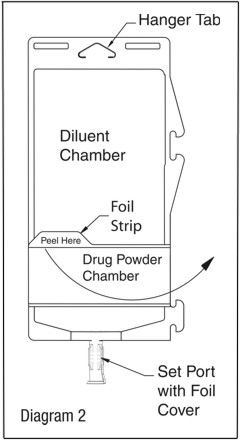
- Protect from light after removal of foil strip.
Note: If foil strip is removed, product must be used within 7 days, but not beyond the labeled expiration date.
- The product should be re-folded and the side tab latched until ready to activate.
Reconstitution (Activation)
- Do not use directly after storage by refrigeration, allow the product to equilibrate to room temperature before patient use.
- Unfold the DUPLEX® Container and point the set port in a downward direction. Starting at the hanger tab end, fold the DUPLEX® Container just below the diluent meniscus trapping all air above the fold. To activate, squeeze the folded diluent chamber until the seal between the diluent and powder opens, releasing diluent into the drug powder chamber. (See Diagram 3.)

- Agitate the liquid-powder mixture until the drug powder is completely dissolved.
Note: Following reconstitution (activation), product must be used within 12 hours if stored at room temperature or within 7 days if stored under refrigeration.
Administration
- Visually inspect the reconstituted solution for particulate matter.
- Point the set port in a downwards direction. Starting at the hanger tab end, fold the DUPLEX® Container just below the solution meniscus trapping all air above the fold. Squeeze the folded DUPLEX® Container until the seal between reconstituted drug solution and set port opens, releasing liquid to set port. (See Diagram 4.)
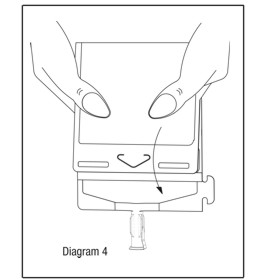
- Prior to attaching the IV set, check for minute leaks by squeezing container firmly. If leaks are found, discard container and solution as sterility may be impaired.
- Using aseptic technique, peel foil cover from the set port and attach sterile administration set. (See Diagram 5.)
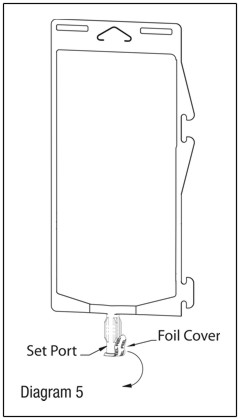
- Refer to Directions for Use accompanying the administration set.
Precautions
- As with other cephalosporins, reconstituted Cefoxitin for Injection and Dextrose Injection tends to darken depending on storage conditions, within the stated recommendations. However, product potency is not adversely affected.
- Use only if prepared solution is clear and free from particulate matter.
- Do not use in series connection.
- Do not introduce additives into the DUPLEX® Container.
- Do not freeze.
HOW SUPPLIED
Cefoxitin for Injection and Dextrose Injection in the DUPLEX® Drug Delivery System is a flexible dual chamber container supplied in two concentrations. After reconstitution, the concentrations are equivalent to 1 g and 2 g cefoxitin. The diluent chamber contains approximately 50 mL of Dextrose Injection. Dextrose Injection has been adjusted to 4% w/v and 2.2% w/v for the 1 g and 2 g doses, respectively, such that the reconstituted solution is iso-osmotic.
Cefoxitin for Injection and Dextrose Injection is supplied sterile and nonpyrogenic in the DUPLEX® Drug Delivery System containers packaged 24 units per case.
| NDC | REF | Dose | Volume |
|---|---|---|---|
| Cefoxitin for Injection and Dextrose Injection | |||
| 0264-3123-11 | 3123-11 | 1 g | 50 mL |
| Cefoxitin for Injection and Dextrose Injection | |||
| 0264-3125-11 | 3125-11 | 2 g | 50 mL |
CLINICAL STUDIES
A prospective, randomized, double-blind, placebo-controlled clinical trial was conducted to determine the efficacy of short-term prophylaxis with cefoxitin in patients undergoing cesarean section who were at high risk for subsequent endometritis because of ruptured membranes. Patients were randomized to receive either three doses of placebo (n=58), a single dose of cefoxitin (2 g) followed by two doses of placebo (n=64), or a three-dose regimen of cefoxitin (each dose consisting of 2 g) (n=60), given intravenously, usually beginning at the time of clamping of the umbilical cord, with the second and third doses given 4 and 8 hours post-operatively. Endometritis occurred in 16/58 (27.6%) patients given placebo, 5/63 (7.9%) patients given a single dose of cefoxitin, and 3/58 (5.2%) patients given three doses of cefoxitin. The differences between the two groups treated with cefoxitin and placebo with respect to endometritis were statistically significant (p<0.01) in favor of cefoxitin. The differences between the one-dose and three-dose regimens of cefoxitin were not statistically significant.
Two double-blind, randomized studies compared the efficacy of a single 2 gram intravenous dose of cefoxitin to a single 2 gram intravenous dose of cefotetan in the prevention of surgical site-related infection (major morbidity) and non-site-related infections (minor morbidity) in patients following cesarean section. In the first study, 82/98 (83.7%) patients treated with cefoxitin and 71/95 (74.7%) patients treated with cefotetan experienced no major or minor morbidity. The difference in the outcomes in this study (95% CI: -0.03, +0.21) was not statistically significant. In the second study, 65/75 (86.7%) patients treated with cefoxitin and 62/76 (81.6%) patients treated with cefotetan experienced no major or minor morbidity. The difference in the outcomes in this study (95% CI: -0.08, +0.18) was not statistically significant.
In clinical trials of patients with intra-abdominal infections due to Bacteroides fragilis group microorganisms, eradication rates at 1 to 2 weeks post-treatment for isolates were in the range of 70% to 80%. Eradication rates for individual species are listed below:
| Bacteroides distasonis | 7/10 | (70%) |
| Bacteroides fragilis | 26/33 | (79%) |
| Bacteroides ovatus | 10/13 | (77%) |
| B. thetaiotaomicron | 13/18 | (72%) |
REFERENCES
- Clinical and Laboratory Standards Institute (CLSI). Methods for Dilution Antimicrobial Susceptibility Tests for Bacteria That Grow Aerobically; Approved Standard - Ninth Edition. CLSI document M07-A9, Clinical and Laboratory Standards Institute, 950 West Valley Road, Suite 2500, Wayne, Pennsylvania 19087, USA, 2012.
- Clinical and Laboratory Standards Institute (CLSI). Performance Standards for Antimicrobial Susceptibility Testing; Twenty-third Informational Supplement, CLSI document M100-S23, Clinical and Laboratory Standards Institute, 950 West Valley Road, Suite 2500, Wayne, Pennsylvania 19087, USA, 2013.
- Clinical and Laboratory Standards Institute (CLSI). Performance Standards for Antimicrobial Disk Diffusion Susceptibility Tests; Approved Standard - Eleventh Edition. CLSI document M02-A11, Clinical and Laboratory Standards Institute, 950 West Valley Road, Suite 2500, Wayne, Pennsylvania 19087, USA, 2012.
- Clinical and Laboratory Standards Institute (CLSI). Methods for Antimicrobial Susceptibility Testing of Anaerobic Bacteria; Approved Standard - Eighth Edition. CLSI document M11-A8, Clinical and Laboratory Standards Institute, 950 West Valley Road, Suite 2500, Wayne, PA 19087 USA, 2012.
DUPLEX is a registered trademark of B. Braun Medical Inc.
ATCC is a registered trademark of American Type Culture Collection.
Clinitest is a registered trademark of Siemens Healthcare Diagnostics Inc.
U.S. Patent Nos. 5,944,709, 6,165,161, 6,203,535, 6,846,305, and 6,996,951.
B. Braun Medical Inc.
Irvine, CA 92614-5895 USA
1-800-227-2862
www.bbraun.com
Made in USA
Y36-002-814
LD-100-3
PRINCIPAL DISPLAY PANEL - 50 mL Container Label
Cefoxitin for Injection
and Dextrose Injection
1g*
REF 3123-11
NDC 0264-3123-11
DUPLEX®
DRUG DELIVERY SYSTEM
50 mL
Use only after mixing contents of both chambers.
For IV Use Only Iso-osmotic Single Dose Sterile/Nonpyrogenic
* Contains cefoxitin sodium equivalent to 1 g cefoxitin.
Reconstitution: Hold container with set port in a downward direction and fold
the diluent chamber just below the solution meniscus. To activate seal, squeeze
folded diluent chamber until seal between diluent and drug chamber opens,
releasing diluent into drug chamber. Agitate the reconstituted solution until the
drug powder is completely dissolved. Fold the container a second time and
squeeze until seal between drug chamber and set port opens.
After reconstitution each 50 mL single dose unit contains: Cefoxitin Sodium USP
(equivalent to 1 g cefoxitin) with approx. 2 g (4% w/v) Hydrous Dextrose USP in
Water for Injection USP. Sodium content is 53.8 mg (2.3 mEq) per gram of cefoxitin.
Approximate osmolality: 290 mOsmol/kg
Prior to Reconstitution: Store at 20-25°C (68-77°F). Excursions permitted to
15-30°C (59-86°F). [See USP Controlled Room Temperature.] Use only if container
and seals are intact. Do not peel foil strip until ready for use. After foil strip
removal, product must be used within 7 days, but not beyond the labeled
expiration date. Protect from light after removal of foil strip.
After Reconstitution: Use only if prepared solution is clear and free from
particulate matter. Use within 12 hours if stored at room temperature or within
7 days if stored under refrigeration. Do not use in a series connection. Do not
introduce additives into this container. Prior to administration check for minute
leaks by squeezing container firmly. If leaks are found, discard container and
solution as sterility may be impaired. Do not freeze.
The DUPLEX Container is Latex-free, PVC-free, and DEHP-free.
Rx only
B. Braun Medical Inc.
Y37-002-402
LD-204-2
Made in USA
PEEL HERE
Drug Chamber
Discard unit if foil strip is damaged. Peel foil strip only when ready for use. Visually inspect drug prior to reconstitution.
See package insert for complete directions for reconstitution and administration.
LD-336-1 X27-001-485
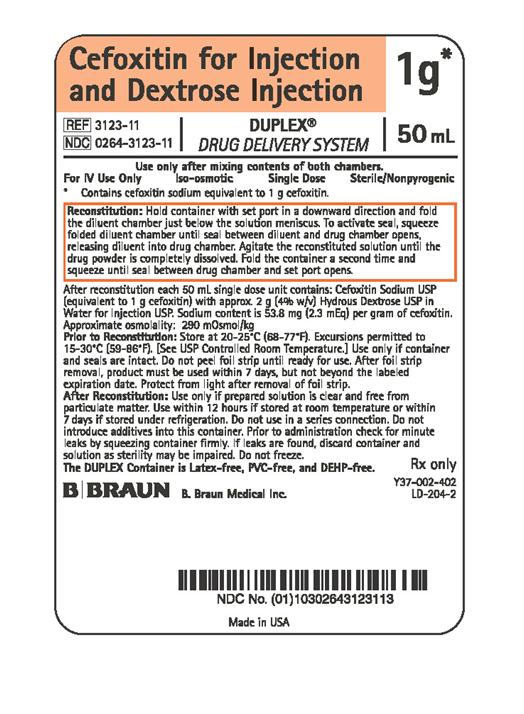

PRINCIPAL DISPLAY PANEL - 50 mL Container Label
Cefoxitin for Injection
and Dextrose Injection
2g*
REF 3125-11
NDC 0264-3125-11
DUPLEX®
DRUG DELIVERY SYSTEM
50 mL
Use only after mixing contents of both chambers.
For IV Use Only Iso-osmotic Single Dose Sterile/Nonpyrogenic
* Contains cefoxitin sodium equivalent to 2 g cefoxitin.
Reconstitution: Hold container with set port in a downward direction and fold
the diluent chamber just below the solution meniscus. To activate seal, squeeze
folded diluent chamber until seal between diluent and drug chamber opens,
releasing diluent into drug chamber. Agitate the reconstituted solution until the
drug powder is completely dissolved. Fold the container a second time and
squeeze until seal between drug chamber and set port opens.
After reconstitution each 50 mL single dose unit contains: Cefoxitin Sodium USP
(equivalent to 2 g cefoxitin) with approx. 1.1 g (2.2% w/v) Hydrous Dextrose USP in
Water for Injection USP. Sodium content is 53.8 mg (2.3 mEq) per gram of cefoxitin.
Approximate osmolality: 290 mOsmol/kg
Prior to Reconstitution: Store at 20-25°C (68-77°F). Excursions permitted to
15-30°C (59-86°F). [See USP Controlled Room Temperature.] Use only if container
and seals are intact. Do not peel foil strip until ready for use. After foil strip
removal, product must be used within 7 days, but not beyond the labeled
expiration date. Protect from light after removal of foil strip.
After Reconstitution: Use only if prepared solution is clear and free from
particulate matter. Use within 12 hours if stored at room temperature or within
7 days if stored under refrigeration. Do not use in a series connection. Do not
introduce additives into this container. Prior to administration check for minute
leaks by squeezing container firmly. If leaks are found, discard container and
solution as sterility may be impaired. Do not freeze.
The DUPLEX Container is Latex-free, PVC-free, and DEHP-free.
Rx only
B. Braun Medical Inc.
Y37-002-403
LD-205-2
Made in USA
PEEL HERE
Drug Chamber
Discard unit if foil strip is damaged. Peel foil strip only when ready for use. Visually inspect drug prior to reconstitution.
See package insert for complete directions for reconstitution and administration.
LD-336-1 X27-001-485
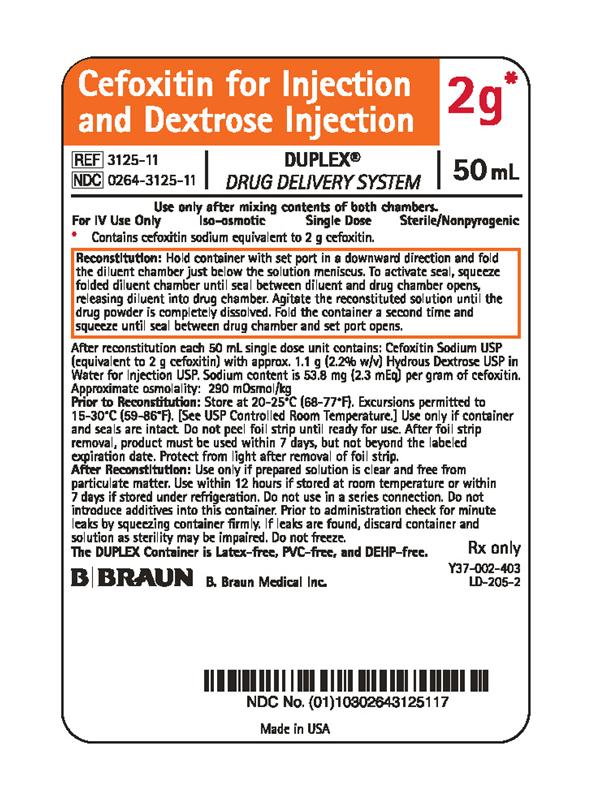
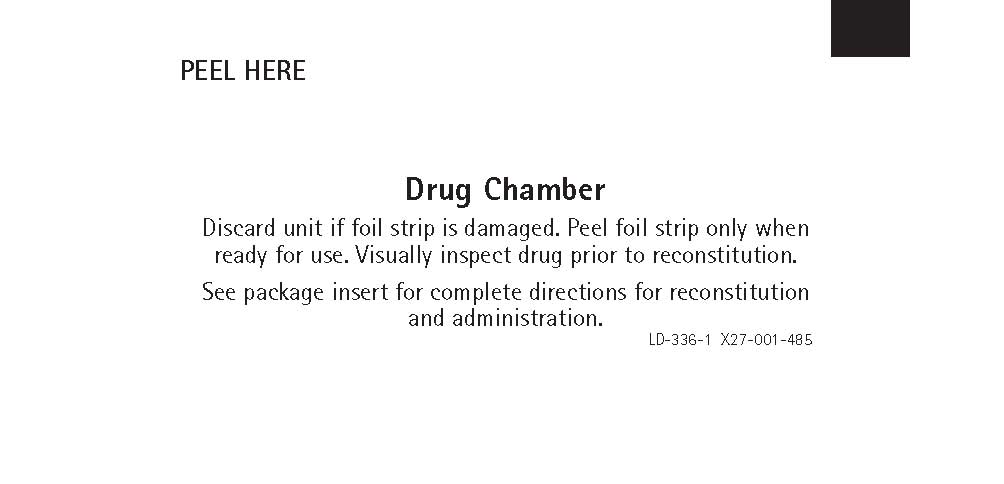
| CEFOXITIN AND DEXTROSE
cefoxitin sodium injection, solution |
|||||||||||||
|
|||||||||||||
|
|||||||||||||
|
|||||||||||||
|
|||||||||||||
|
|||||||||||||
| CEFOXITIN AND DEXTROSE
cefoxitin sodium injection, solution |
|||||||||||||
|
|||||||||||||
|
|||||||||||||
|
|||||||||||||
|
|||||||||||||
|
|||||||||||||
| Labeler - B. Braun Medical Inc. (002397347) |